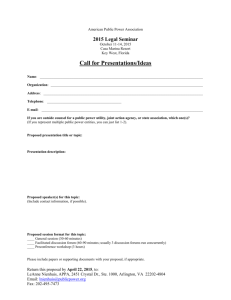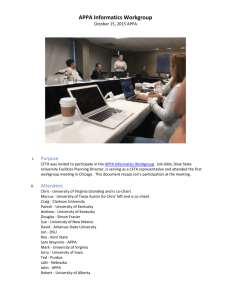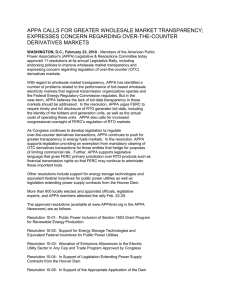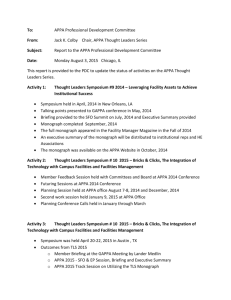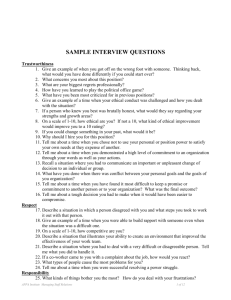Initial Characterization of the Primary Photochemistry of AppA,
advertisement
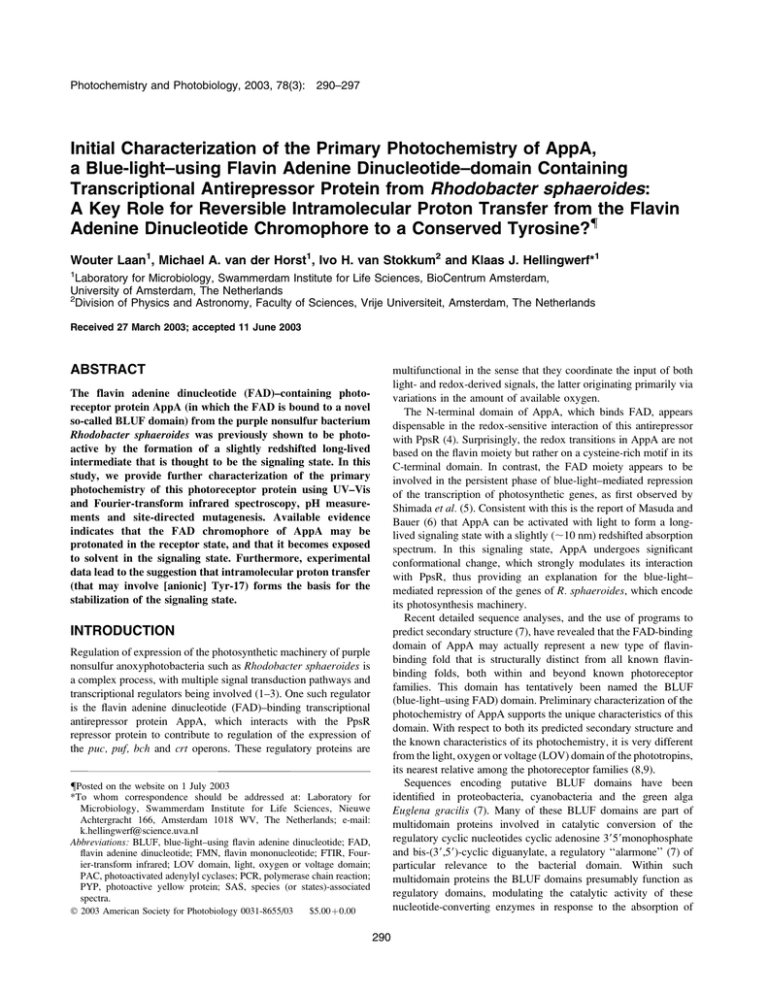
Photochemistry and Photobiology, 2003, 78(3):
290–297
Initial Characterization of the Primary Photochemistry of AppA,
a Blue-light–using Flavin Adenine Dinucleotide–domain Containing
Transcriptional Antirepressor Protein from Rhodobacter sphaeroides:
A Key Role for Reversible Intramolecular Proton Transfer from the Flavin
Adenine Dinucleotide Chromophore to a Conserved Tyrosine?{
Wouter Laan1, Michael A. van der Horst1, Ivo H. van Stokkum2 and Klaas J. Hellingwerf*1
1
Laboratory for Microbiology, Swammerdam Institute for Life Sciences, BioCentrum Amsterdam,
University of Amsterdam, The Netherlands
2
Division of Physics and Astronomy, Faculty of Sciences, Vrije Universiteit, Amsterdam, The Netherlands
Received 27 March 2003; accepted 11 June 2003
ABSTRACT
multifunctional in the sense that they coordinate the input of both
light- and redox-derived signals, the latter originating primarily via
variations in the amount of available oxygen.
The N-terminal domain of AppA, which binds FAD, appears
dispensable in the redox-sensitive interaction of this antirepressor
with PpsR (4). Surprisingly, the redox transitions in AppA are not
based on the flavin moiety but rather on a cysteine-rich motif in its
C-terminal domain. In contrast, the FAD moiety appears to be
involved in the persistent phase of blue-light–mediated repression
of the transcription of photosynthetic genes, as first observed by
Shimada et al. (5). Consistent with this is the report of Masuda and
Bauer (6) that AppA can be activated with light to form a longlived signaling state with a slightly (;10 nm) redshifted absorption
spectrum. In this signaling state, AppA undergoes significant
conformational change, which strongly modulates its interaction
with PpsR, thus providing an explanation for the blue-light–
mediated repression of the genes of R. sphaeroides, which encode
its photosynthesis machinery.
Recent detailed sequence analyses, and the use of programs to
predict secondary structure (7), have revealed that the FAD-binding
domain of AppA may actually represent a new type of flavinbinding fold that is structurally distinct from all known flavinbinding folds, both within and beyond known photoreceptor
families. This domain has tentatively been named the BLUF
(blue-light–using FAD) domain. Preliminary characterization of the
photochemistry of AppA supports the unique characteristics of this
domain. With respect to both its predicted secondary structure and
the known characteristics of its photochemistry, it is very different
from the light, oxygen or voltage (LOV) domain of the phototropins,
its nearest relative among the photoreceptor families (8,9).
Sequences encoding putative BLUF domains have been
identified in proteobacteria, cyanobacteria and the green alga
Euglena gracilis (7). Many of these BLUF domains are part of
multidomain proteins involved in catalytic conversion of the
regulatory cyclic nucleotides cyclic adenosine 3959monophosphate
and bis-(39,59)-cyclic diguanylate, a regulatory ‘‘alarmone’’ (7) of
particular relevance to the bacterial domain. Within such
multidomain proteins the BLUF domains presumably function as
regulatory domains, modulating the catalytic activity of these
nucleotide-converting enzymes in response to the absorption of
The flavin adenine dinucleotide (FAD)–containing photoreceptor protein AppA (in which the FAD is bound to a novel
so-called BLUF domain) from the purple nonsulfur bacterium
Rhodobacter sphaeroides was previously shown to be photoactive by the formation of a slightly redshifted long-lived
intermediate that is thought to be the signaling state. In this
study, we provide further characterization of the primary
photochemistry of this photoreceptor protein using UV–Vis
and Fourier-transform infrared spectroscopy, pH measurements and site-directed mutagenesis. Available evidence
indicates that the FAD chromophore of AppA may be
protonated in the receptor state, and that it becomes exposed
to solvent in the signaling state. Furthermore, experimental
data lead to the suggestion that intramolecular proton transfer
(that may involve [anionic] Tyr-17) forms the basis for the
stabilization of the signaling state.
INTRODUCTION
Regulation of expression of the photosynthetic machinery of purple
nonsulfur anoxyphotobacteria such as Rhodobacter sphaeroides is
a complex process, with multiple signal transduction pathways and
transcriptional regulators being involved (1–3). One such regulator
is the flavin adenine dinucleotide (FAD)–binding transcriptional
antirepressor protein AppA, which interacts with the PpsR
repressor protein to contribute to regulation of the expression of
the puc, puf, bch and crt operons. These regulatory proteins are
{Posted on the website on 1 July 2003
*To whom correspondence should be addressed at: Laboratory for
Microbiology, Swammerdam Institute for Life Sciences, Nieuwe
Achtergracht 166, Amsterdam 1018 WV, The Netherlands; e-mail:
k.hellingwerf@science.uva.nl
Abbreviations: BLUF, blue-light–using flavin adenine dinucleotide; FAD,
flavin adenine dinucleotide; FMN, flavin mononucleotide; FTIR, Fourier-transform infrared; LOV domain, light, oxygen or voltage domain;
PAC, photoactivated adenylyl cyclases; PCR, polymerase chain reaction;
PYP, photoactive yellow protein; SAS, species (or states)-associated
spectra.
Ó 2003 American Society for Photobiology 0031-8655/03
$5.00þ0.00
290
Photochemistry and Photobiology, 2003, 78(3)
blue photons. As with the individual domains of many other
multidomain proteins, however, BLUF domains can also be
present as small self-contained single-domain proteins. ORF7291178 from Klebsiella pneumoniae exemplifies that possibility. In
agreement with the above, the BLUF domain–containing proteins
from E. gracilis have been demonstrated to be blue-light–activated
adenylyl cyclases (photoactivated adenylyl cyclases [PAC] [10]).
In view of the unique structural and functional features of AppA,
characterization of its photochemical activation, and of the
subsequent formation of its signaling state, is of particular interest.
As previously mentioned, a brief pulse of blue light generates
a long-lived (t1/2 ¼ hundreds of seconds) intermediate that is
thought to be the signaling state of AppA. The most striking
difference between this state and the receptor state (which is stable
in the dark) is a small (;10 nm) redshift of the absorption spectrum
of the FAD chromophore. Furthermore, molecular sieve chromatography has revealed a measurable difference in the radius of
gyration of the receptor and signaling states of AppA, with the
signaling state having the largest radius of gyration (6). The BLUF
domains bind FAD noncovalently, as the LOV domains bind flavin
mononucleotide (FMN), in an occluded pocket that is shielded
from the solvent. Surprisingly, the fluorescence excitation
spectrum of the PAC proteins does not show vibrational fine
structure (10). This contrasts, however, with the fluorescence
properties of all LOV domains and the absorption characteristics of
the AppA protein from R. sphaeroides (6).
The UV–Vis absorbance characteristics of the putative signaling
state of the BLUF domain differ from those of the signaling states
of all other known photoreceptor proteins. This suggests that the
BLUF domain displays an entirely new type of primary photochemistry, different not only from the well-known E/Z photoisomerization of rhodopsins, phytochromes and xanthopsins but also
from the FMN–cysteinyl adduct formation characteristic of the
LOV domains of phototropins.
In this study, we present data that may indicate that the FAD
chromophore of AppA is protonated in the receptor state and
deprotonated in the signaling state (as deduced from Fouriertransform infrared [FTIR] spectra), and that the conserved tyrosine
in the N-terminus of AppA is crucial for wild-type photochemistry.
The FAD chromophore appears to be occluded both in the receptor
and in the signaling states of AppA, albeit to a smaller extent in the
latter state.
MATERIALS AND METHODS
Strains and growth conditions. Cloning and heterologous overexpression
of the N-terminal domain of AppA were performed in Escherichia coli,
grown in Luria–Bertani or P-broth medium (containing 20 g L1 tryptone,
10 g L1 yeast extract, 5 g L1 dextrose, 5 g L1 NaCl and 8.7 g L1
K2HPO4, pH 7.0), using established protocols. Ampicillin and kanamycin
were used at 100 and 50 lg mL1, respectively.
Plasmid construction. Using genomic DNA from R. sphaeroides 2.4.1.
strain RK1 as a template, the DNA fragment coding for amino acids 5–
125 of AppA was amplified with the sense primer AppA5125F, 59GCACGGATCCGATGACGATGACAAACTCGAGGCGGACGTCACG-39
(BamHI restriction site underlined, enterokinase site in italics) and
the antisense primer AppA5125R, 59-GCTTAAGCTTACTGCCGGCTCTCGGCCAG-39 (HindIII site underlined). The BamHI–HindIII-digested
polymerase chain reaction (PCR) product was ligated to BamHI–HindIIIdigested pQE30 to yield the plasmid pQEAppA5–125. The construct was
verified by sequencing (BaseClear, Leiden, The Netherlands).
Site-directed mutagenesis. The Y17I mutant was constructed with the
QuickChange site-directed mutagenesis kit (Stratagene, La Jolla, CA).
pQEAppA5–125 was used as the template for PCR, and the primer sequences
were 59-CTGGTTTCCTGCTGCATTCGCAGCCTGGCGGC-39 and 59-
291
GCCGCCAGGCTGCGAATGCAGCAGGAAACCAG-39. The construct
was verified by sequencing (BaseClear).
Protein expression and purification. E. coli M15 pREP4, transformed
with pQEAppA5–125, was grown in P-broth medium containing kanamycin
(50 lg mL1) and ampicillin (100 lg mL1) at 308C. When the culture
reached an optical density of 0.6 at a wavelength of 600 nm, protein
expression was induced by adding 0.4 mM isopropyl-thio-b-D-galactoside.
Growth was allowed to continue for 16 h before the cells were harvested by
centrifugation, resuspended in ice-cold lysis buffer (50 mM Tris–HCl, pH
8.0, 150 mM NaCl, 0.1% [wt/vol] Triton-X100, 15% glycerol and 1 mM
PefaBloc) and treated with deoxyribonuclease (30 lg mL1), ribonuclease
(30 lg mL1) and lysozyme (1 mg mL1). Held on ice for 30 min, the
suspension was subsequently sonicated (with a 50% duty cycle) and
centrifuged at 16 000 rpm for 45 min. The soluble fraction was applied to
a Ni–nitrilotriacetic acid–agarose column, the column was washed with 50
mM Tris–HCl, pH 8.0, 500 mM NaCl and 20 mM imidazol, and AppA was
eluted with 50 mM Tris–HCl, pH 8.0, 500 mM NaCl and 250 mM imidazol.
The eluted protein was dialysed against 50 mM Tris–HCl, pH 7.8, 500 mM
NaCl and 1 mM ethylenediaminetetraacetic acid and stored in the dark at
48C. Protein concentrations were determined based on the assumption that
the extinction coefficient of 11.3 mM1 cm1 at 450 nm of free FAD (11) is
equal to that of protein-bound FAD. Purity of the samples was checked with
sodium dodecyl sulfate–polyacrylamide gel electrophoresis.
Fourier-transform infrared spectroscopy. AppA was concentrated to
about 600 lM in 10 mM Tris–HCl, pH 8.0, using a Microcon filter. A 10 lL
sample was placed on a CaF2 window and dried under vacuum. This was
repeated several times, after which the dried protein was resuspended in
20 lL of 10 mM Tris–HCl, pH 8.0. The rehydrated sample was then
sandwiched between this and a second CaF2 window, using a 12 lm
polyethylene spacer. Measurements were performed on a Bio-Rad FTS 60A
spectrometer, equipped with a KBr beam splitter and a liquid nitrogen–
cooled mercury–cadmium–telluride detector. The spectra were recorded at
208C with a resolution of 2 cm1 and are averages of 762 scans. The spectra
were corrected for water vapor and instrument drift, without further
smoothing. To convert AppA from the receptor to the signaling state, the
sample was illuminated for 2 min using a 450 W xenon-arc lamp (XBO-450
OFR, Osram, München, Germany) in a LAX 1450 lamp housing (Müller
Elektronik-Optik, Moosinning, Germany) equipped with a long-pass filter
5146 (.345 nm, Oriel, Stanford, UK). After passing a water filter (Oriel
liquid filter), the light was guided into a glass fiber optic bundle by an Oriel
fiber bundle–focusing assembly. The fiber bundle was led into the sample
compartment of the spectrometer, illuminating the sample under an angle of
approximately 308.
FTIR spectra of protonated and deprotonated FAD were obtained using
a solution of 20 mM FAD in 10 mM citrate buffer, pH 5.0, and in 0.1 M
NaOH, respectively.
Simultaneous transient UV–Vis absorption and pH measurements. Absorption and pH signals were measured simultaneously by placing
a ‘‘Kraayenhof vessel’’ (12) in the sample compartment of a Hewlett
Packard 8453 spectrophotometer (Portland, OR). Two of the four available ports of the vessel were used for the measuring beam of the
spectrophotometer, and a third one was used for a Mettler Toledo micro
(combination)-electrode (InLab423) connected to a Dulas Engineering
amplifier. The amplified signal was fed into a linear strip-chart recorder
(Kipp & Zonen, Delft, The Netherlands, type BD41). Continuous actinic
illumination was provided through the fourth port of the vessel from
a Schott KL1500 light source (containing a 150 W halogen lamp). To
avoid heating of the sample, the light was filtered through a band-pass
filter (450 nm, full-width half-maximum 10 nm). pH changes were
converted to moles of protons by calibration with microliter amounts of
2.5 mM oxalic acid.
AppA was used at a concentration of 110 lM in a working volume of 1.9
mL, using an unbuffered solution of 1 M KCl. pH titrations of FAD (in 1 M
KCl) and AppA (in 10 mM Tris) were carried out by adding microliter
amounts of 1 M NaOH or HCl solution. The titration data were analyzed
using the Henderson–Hasselbalch equation.
For measurement of the rate of receptor state recovery, AppA (;20 lM
in 10 mM Tris–HCl, pH 8, 9, 10 or 11) was irradiated with saturating actinic
white light from the Schott KL1500 light source and allowed to revert to the
receptor state in the dark. Spectra were recorded every 120 s for 45 min.
The absorption changes at 410, 420 and 444 nm were analyzed by mono
and biexponential fits to the data using Origin software (Microcal Software
Inc., Northampton, MA). Global analysis of the time-gated spectra (13)
was performed using a sequential model: 1 ! 2 ! 3. The estimated model
292 Wouter Laan et al.
Figure 1. Sequence alignment of the Nterminal domain of AppA from two
strains of R. sphaeroides (i.e. 2.4.1. and
RK1). The sequence of the cloned PCR
fragment was aligned with the deposited
sequence (accession no. L42555) using
Clustal W (http://www.ebi.ac.uk/clustalw/). Base pair and resulting amino
acid substitutions are highlighted in
reverse contrast. The conserved tyrosine
(#17), target for site-directed mutagenesis
in this study, has been circled and is
represented in bold.
parameters are the lifetimes and species (or state)-associated spectra (SAS)
of states 1, 2 and 3.
RESULTS
The N-terminal domain of AppA from R. sphaeroides RK1
To obtain an expression plasmid for the flavin-containing Nterminal domain of AppA, a DNA fragment encoding amino acids
5–125 was amplified by PCR using chromosomal DNA of R.
sphaeroides RK1 (14) and subsequently cloned in E. coli (see
Materials and Methods). Surprisingly, the sequence of the DNA
fragment obtained contained five single–base pair substitutions
as compared with the sequence of the corresponding domain of
AppA from R. sphaeroides strain HR, deposited in the database
(accession number L42555; see also Fig. 1). Repetitive PCR
amplification and subsequent sequencing confirmed that the
sequence differences are not the result of PCR errors but are
specific to the Rhodobacter strain used. Only three of the DNA
substitutions lead to changes at the protein level: R64H, T72S and
P92S (numbering according to the sequence of the amplified
fragment of RK1); the other two are silent mutations. The three
substituted amino acids do not belong to the conserved residues in
BLUF domains (7); they also do not seem to have an identifiable
effect on the FAD binding nor the spectral properties of AppA.
observations suggest that in the physiological pH range, the
receptor state of AppA contains a protonated flavin.
Blue light activates signaling state formation in AppA over
a wide range of pH values, from 7 to values higher than 11. Under
acidic pH conditions, AppA is not soluble in the buffer systems
tested. The spectrum of the long-lived putative signaling intermediate of AppA shows, besides a shift to longer wavelengths
(see further below), one notable feature: the flavin vibrational fine
structure at the high-energy side of the main UV–Vis transition (i.e.
from 400 to 430 nm) is lost in this state (see e.g. Fig. 2). However,
The photocycle of AppA: kinetics and SAS
In contrast to the observation of Masuda and Bauer (6), our initial
analyses indicated that the signaling state of AppA from R.
sphaeroides RK1 can also be formed, albeit less efficiently, with
light ,300 and .500 nm (data not shown). The spectra of the
receptor and the signaling states obtained, however, are very
similar to those of the HR strain (see Fig. 2a). The absorbance
maximum of the long-wavelength absorbance band of the flavin
is at 444 and 458 nm for the receptor and signaling state,
respectively. This may be compared to 449 and 454 nm of free
flavin, which undergoes a deprotonation of the N3 atom of the
isoalloxazine ring in aqueous solution, with a pKa of 10.1 (15).
Titration of AppA through the pH range from 7.5 to 14, with
simultaneous measurement of absorbance spectra, reveals that the
pKa of the FAD chromophore in the AppA protein has shifted to
a value of 11.7 (displaying the typical more strongly cooperative
transition of a protein-bound chromophore, i.e. with an n value of
1.4 and 0.6 for free and protein-bound flavin, respectively). These
Figure 2. Time dependence of the recovery of the receptor state of AppA
(a) and SAS that have a role in this process (b–e). AppA was converted to
the signaling state by illumination with white light and allowed to revert to
the receptor state in the dark. a: Spectra of the signaling state (gray), 10 min
after switching off the actinic illumination (black) and of the receptor state
(dotted). The pH in this experiment was 8.0. b,c: SAS at pH 8.0: spectra of
the state with a lifetime of 1043 s (black) and the receptor state (gray). d,e:
SAS at pH 11.0: spectra of the states with lifetimes of 307 s (black) and
4800 s (dotted) and the receptor state (gray) a.u., absorption units.
Photochemistry and Photobiology, 2003, 78(3)
Table 1. pH dependence of the rate of dark recovery of AppA. The rate of
the dark recovery of the receptor state at different pH was determined by
fitting a plot of the absorbance changes at 444 nm with a monoexponential
decay function with Origin software
293
changes in this spectral region, such as a decrease in the region
around 295 nm and an increase at 274 nm. Such changes may be
caused by a simultaneous phenolate to phenol transition, for example in tyrosine.
Rate (3103 s1)
pH
A role for Y17 in the photocycle of AppA
8.0
9.0
10.0
11.0
1.02
1.07
1.28
3.34
6
6
6
6
0.04
0.02
0.03
0.04
because the low-energy fine structure persists, it is difficult to
conclude to what extent the flavin is more extensively exposed to
polar solvent in this state. The rate of the recovery reaction is
slightly pH dependent. This process accelerates approximately
three-fold on an increase in pH from 8 to 11 (i.e. from 1 103 s1
to 3 103 s1 when fitted monoexponentially, Table 1). At alkaline
pH, recovery of the receptor state is no longer monoexponential.
Under these conditions it is most optimally fit with a biexponential
function. At pH 11 the recovery rates are 3.4 103 s1 and 0.7 103 s1 for the fast and slow phase of the reaction, respectively
(Table 2).
An initial inspection of the spectra (e.g. see the 10 min spectrum
in Fig. 2a) may lead one to conclude that the vibrational fine
structure is lost completely. Detailed (global) analysis, however,
shows that this is not the case. The SAS obtained during the
recovery process do show this fine structure (Fig. 2c,e); they show
only small differences in the high-energy flavin absorption band
(i.e. in the range from 320 to 420 nm) and in the UV region (Fig.
2b,d). It is possible that the mixture of the two states present at the
intermediate time points blurs visibility of the fine structure.
Changes in the protonation state of a tyrosine side chain might
contribute to these signals (see Fig. 3 and further below).
Analysis of the signaling state
and receptor state UV–Vis difference spectrum
As noted by Masuda and Bauer (6), the difference spectrum
between signaling and receptor states of AppA suggests that light
induces a redshift in the flavin spectrum. The analysis in Fig. 3a
confirms that a difference spectrum of a modeled isoenergetic shift
of the spectrum of the receptor state of AppA reproduces the
difference spectrum rather well in the visible part of the spectrum,
including the fine structure at 460, 430, 360 and 345 nm.
Nevertheless, there is a strong deviation between the two spectra in
the UV region: whereas the predicted difference spectrum shows
large amplitudes in the 250–325 nm region, the observed difference spectrum actually shows much smaller amplitudes (Fig.
3b). This may be caused by additional, compensating, absorbance
On the basis of experimental evidence that indicates that the
receptor state of AppA contains, or may contain, a protonated
flavin and data illustrating that spectral changes occur in the UV
region during transition to the signaling state, it is possible to
speculate that a tyrosinate may be involved in the photocycle of
AppA, e.g. as a transient acceptor of a proton donated by the flavin.
We thus replaced the strictly conserved (that is, in the BLUF
family) Y17 of AppA (i.e. Y21 in the numbering of Gomelsky and
Klug [7]) with an isoleucine and produced and purified the Y17I
variant through heterologous expression in E. coli (for further
details see Materials and Methods). Figure 4 shows that by
following this procedure, an authentically colored protein is
formed. The visible spectrum of the Y17I variant is in shape
rather similar to that of the receptor state from the wild-type
derivative but, overall, slightly (i.e. 4 nm) blueshifted with an
altered (i.e. decreased) intensity ratio of the high- over the lowenergy absorption band of the flavin and the absence of vibrational
fine structure in the region from 400 to 430 nm. Importantly, this
derivative turned out to be completely inactive in photocycling
under all illumination conditions tested.
FTIR analyses of light-induced difference spectra of AppA
Because of the possibility that changes in the protonation state of
the flavin may accompany the photocycle transitions in AppA, we
used static light–induced FTIR difference spectroscopy for its
further characterization. Because the recovery rate of the receptor
state of AppA is slow, it is relatively straightforward to convert the
photoreceptor protein into a high steady-state concentration of its
signaling state with actinic illumination. To confirm the quantitative conversion of AppA to the signaling state under the conditions
of the FTIR measurements, UV–Vis measurements were carried
out in parallel (data not shown).
The FTIR difference spectrum obtained (Fig. 5) shows many
features in the range from 1000 to 1800 cm1, which is dominated
(i.e. by having the largest difference extinction coefficient) by
a band shift from 1710 to 1698 cm1. This latter feature can be
assigned to the C¼O of the C4 atom of the isoalloxazine ring
(16,17). This is confirmed by the comparison between the lightinduced FTIR difference spectrum and the FTIR spectra of free
FAD in buffer at acidic and alkaline pH (see spectra I and III in
Fig. 5b). These FTIR spectra of FAD in the protonated and
deprotonated states may also explain many features in the light-
Table 2. Mono- versus biexponential decay of the receptor state of AppA as a function of pH. Data deconvolution was performed both at single
wavelengths and by global analysis. A1 and A2 are the amplitudes of the fast and slow components, respectively. The values for the single wavelength
analysis are the average from recordings at 410 and 420 nm
Single wavelengtha
Global analysisa
pH
Rate1 (3103 s1)
A1 (%)
Rate2 (3103 s1)
A2 (%)
Rate1 (3103 s1)
Rate2 (3103 s1)
8.0
11.0
1.01 6 0.01
3.43 6 0.06
100
82 6 3
NA
0.66 6 0.2
NA
18 6 3
0.96
3.26
NA
0.21
a
not applicable.
294 Wouter Laan et al.
Figure 3. AppA difference spectra (þ/ illumination) in the UV–Vis
region. a: AppA difference spectrum as a function of wavelength. b: AppA
difference spectrum as a function of wavenumber (black) and the difference
spectrum of a simulated 800 cm1 redshifted ground-state spectrum minus
the ground-state spectrum (gray). a.u., absorption units.
Figure 5. Initial FTIR characterization of AppA. a: FTIR difference
spectra measured every 6 min during dark reversion of the signaling state.
b: Comparison of the light-induced difference spectrum of AppA (II) with
the FTIR spectra of deprotonated (I) and protonated (III) FAD in aqueous
buffer (NaOH–citrate) at high (I) and low (III) pH, respectively. The
vertical dotted lines correspond to the frequency of the negative and
positive bands of the AppA difference spectrum, which align with bands in
the spectra of protonated and deprotonated FAD, respectively. a.u.,
absorption units.
induced difference spectrum in the region from 1000 to 1600 cm1.
In this same spectral region, contributions from a change in
protonation state of a tyrosinate would be expected. Close
inspection of this region shows that at some (but not all) of the
expected positions changes do occur (e.g. at 1451 and 1443 cm1).
Test of light-induced proton release by AppA
Figure 4. UV–Vis spectrum of the Y17I variant of AppA. This spectrum
was recorded in 10 mM Tris–HCl at pH 8.0 and room temperature. a.u.,
absorption units.
In many photoreceptor proteins, proton transfer accompanies light
activation. This can be either to an intramolecular or external
acceptor (e.g. the buffer; see for instance Sasaki and Spudich [18]).
Besides protons from the chromophore, Bohr protons may be
released because of the conformational transitions associated with
signal generation (see, e.g. responses in photoactive yellow protein
[PYP] and Cph1). Because the FTIR difference spectra of AppA
indicate that proton transfer is involved in photoactivation of
the photoreceptor protein, we tested whether protons are released
into the solvent on blue-light illumination of AppA. The results
obtained (Fig. 6) reveal that no significant proton release occurs
(i.e. less than 0.07 Hþ/AppA, as can be deduced from a comparison
with the size of the calibration pulse) on signaling state formation.
The use of blue light in this experiment is important because white
light illumination caused significant heating artifacts. The latter
Photochemistry and Photobiology, 2003, 78(3)
Figure 6. Absence of detectable proton release on formation and decay of
the signaling state of AppA, in parallel to UV–Vis absorbance changes. a:
Recording of the pH changes during formation and decay of the signaling
state of AppA at pH 8.0. Arrows 1 and 2: actinic light on and off,
respectively; 3a and 3b: addition of 15 and 30 nmoles of Hþ, respectively.
The diagonal trend in the trace is due to instrument drift. b: Absorption
changes recorded at 495 nm and measured simultaneously. a.u., absorption
units.
was confirmed with measurements on the Y17I protein. Parallel
absorbance measurements confirmed that the intensity of the blue
light was sufficient to drive the majority of the AppA proteins into
the signaling state (Fig. 6b).
DISCUSSION
Light sensing in biology is mediated by a limited number of
photoreceptor families. Photoreceptor proteins belonging to the
rhodopsins, the phytochromes and the xanthopsin family are all
activated by light-induced E/Z (i.e. trans/cis) isomerization of
a particular double bond in their chromophores (i.e. retinaldehyde,
phytochromobilin and p-coumaric acid, respectively [8]). The
change in the configuration of such a chromophore leads to
changes in the conformation of the surrounding apoprotein, which
results in formation of the signaling state. Both the cryptochrome
and the phototropin families carry a flavin as chromophore,
a compound lacking an isomerizable double bond. For cryptochrome, the mechanism of activation has been postulated to be
a light-induced redox reaction involving electron transfer (19) (P.
Galland, unpublished), whereas in phototropins light absorption
leads to formation of a covalent flavin–cysteinyl adduct (20). With
295
the recent demonstration that AppA functions as a blue-light
photoreceptor that antirepresses photosynthesis gene expression in
R. sphaeroides (6) and the fact that the widely distributed
N-terminal flavin binding (BLUF) domain may actually represent
a new flavin fold, involved in signal transduction (7), a new family
of photoreceptors seems set to emerge.
Our results suggest that the mechanism of signaling state
formation in this new family involves the deprotonation of the
FAD chromophore, a process in which a conserved tyrosine may
function as the proton acceptor. Besides intramolecular proton
transfer, there is another interesting parallel between AppA and
PYP: both appear to display considerable conformational change
between receptor and signaling states (e.g. Hoff et al. [21]; Masuda
and Bauer [6]).
Sequence analysis indicates that the differences observed
between the fragment of AppA cloned in the present study and
the sequence deposited in the database probably arise from strain
differences between R. sphaeroides strains HR and RK1. R.
sphaeroides 2.4.1. strain RK1 is an interesting strain with respect
to its motility response to changes in light conditions. Under
anaerobic conditions, R. sphaeroides responds to a decrease
in photosynthetic light intensity by an increase in its stop or
reorientation frequency. The photosynthetic apparatus is the
photoreceptor for this response (22). In addition, however, the
RK1 strain shows a similar increase in its stop frequency on an
increase in blue-light intensity, independent of the number of
photosynthetic pigments per cell, suggesting that a separate sensor
mediates this latter response (23). Interestingly, the genome of R.
sphaeroides contains, in addition to the gene encoding AppA, two
other genes encoding BLUF-domain proteins. One of these
(ORF5263) has a chromosomal context in which other putative
taxis-related genes are involved. It is therefore tempting to
speculate that this latter protein is the photoreceptor for the bluelight motility response displayed by this organism (23).
An intriguing aspect of the manner in which AppA functions is
the mechanism of stabilization of its signaling state. In this study,
we report that signaling state formation is likely to be based on
reversible proton transfer from its flavin cofactor to (an) acceptor(s)
in the apoprotein, possibly a tyrosinate. In most biological systems
investigated to date, proton transfer reactions have been shown to
be rapidly reversible (e.g. Hendriks et al. [13]). Although we have
not yet fully time-resolved the reaction that leads to deprotonation
of the flavin, our initial observations indicate that this reaction
proceeds faster than the microsecond timescale. As a first-order
approximation one would expect the lifetime of the signaling state
(or the reprotonation of the flavin) to be of the same order of
magnitude. Clearly, the results show that recovery of the signaling
state is many orders of magnitude (i.e. at least 107-fold) slower (see
e.g. Fig. 2). This paradox shows some similarities with the problem
of understanding stabilization of charge separation in photosynthetic reaction centers (e.g. Allen, J. P. and. J. C. Williams [24]).
Nature has solved this problem by arranging several (electron)
acceptors in series. It will be interesting to determine whether
a similar solution has evolved in the BLUF family for forward
proton transfer. Strikingly, reaction centers appear to use that same
solution not only for electrons but also for proton transfer toward
their secondary ubiquinone acceptor site (25).
The recovery rate of the receptor state of AppA increases about
three-fold on an increase in pH from 8 to 11. This may be caused by
a gradual decrease in stability of the receptor state with increasing
pH. Titration of AppA from pH 7.5 to 14 revealed that the ground
296 Wouter Laan et al.
state was stable over this pH range. Surprisingly, the signaling state
of AppA was much more alkaline labile. Flavins in oxidoreductase
enzymes often display ‘‘in–out’’ conformational transitions. Should
this apply to the two states of AppA, the decreased vibrational fine
structure (around 415 nm) associated with the signaling state would
presumably indicate an ‘‘out’’ conformation. Nevertheless, its pKa is
considerably different from the pKa of FAD in water. This indicates
that the flavin must still be in a confined environment. Fluorescence
studies may shed further light on this. In view of these properties of
the flavin it will also be of interest to determine its redox midpoint
potential. Mutation of Tyr-17 into an isoleucine makes the flavinbinding pocket less polarizable. The observed shift in the position
and absorbance ratio of the peaks in the flavin absorption spectrum
of the mutant protein Y17I is consistent with this.
The spectral difference between the receptor and signaling states
is presumably caused primarily by a difference in the protonation
state of the flavin. Deprotonation of free flavin results in a 5 nm
redshift and an 18 nm blueshift of the absorption maxima of the
long- and short-wavelength absorbance band, respectively (22).
A 25 nm redshift of the short-wavelength absorbance band is
observed between flavin dissolved in Me2SO and H2O as a result
of increased hydrogen bonding (23). Signaling state formation in
AppA involves a redshift in both absorbance bands, suggesting that
the postulated deprotonation of FAD is accompanied by an
increase in hydrogen bonding, which is in agreement with the loss
of vibrational fine structure at the high-energy side of the main
UV–Vis transition in the signaling state. The observation that the
spectral transition in the longer-wavelength absorption band is
slightly different from the corresponding transition of free FAD in
aqueous buffer may be explained by the regio-selective protonation
of the protein-bound flavin. Nevertheless, additional factors may
also contribute, such as the (de)stacking of the flavin with (an)
aromatic ring(s) or a cation of nearby amino acid side chains (or
both). Such effects will presumably be additive.
The FTIR difference spectrum shows several bands in the 1100–
1300 cm1 region. Most of these are affected by the hydrogen
bonding to the flavin and have been shown to involve the N3
proton (26). Only part of the bands in the FTIR difference spectrum
has been assigned to date. It is possible that both the negative
bands at 1443 and 1267 cm1 (atypical for a flavin) and the positive
bands at 1453 and 1380 cm1 are due to a tyrosinate to tyrosine
transition (see Table 3). Additional bands to be expected in such
a transition, but not clearly visible in the FTIR difference spectrum,
overlap with flavin peaks or are in the 1500–1700 cm1 region, or
both, from which–probably result from excessive IR absorption by
water–no identifiable signals were obtained. The absorption peaks
in the FTIR spectrum (Fig. 5a) reveal differences in their relaxation
characteristics. This may be due to independent contributions by,
for example, the flavin and the Amide I absorption of the peptide
bonds. Future (time-resolved) FTIR studies with an improved
signal to noise ratio will be carried out to reveal whether these
differences can be resolved into (an) additionally identifiable
state(s) during the recovery of the receptor state of AppA and
whether bands can be assigned to a tyrosinate–tyrosine transition.
The studies reported in this communication have been performed
with the N-terminal flavin-carrying domain of AppA. This is the
part of the protein in which the initial conversion of photon energy
into protein conformational changes takes place. To fully understand the photoreceptor function of AppA, it will be very
important to extend these studies to full-length AppA. In those
studies it will also be possible, and of great interest, to investigate
Table 3. FTIR band positions of tyrosine and tyrosinate. Positions are
given in cm1. Data are from Hienerwadel et al. (27)
Tyrosine
Tyrosinate
1616
1600
1518
1451
1376
1290
1248
1179
1111
1600
1560
1499
1443
1413
1355
1330
1273
1174
1110
the integration of light and redox signals that regulate expression of
the photosynthesis genes of R. sphaeroides.
In addition to the Y17L mutation, an Y17F mutation has been
constructed. Although the latter is a more conservative replacement, the two mutant proteins are spectroscopically very similar
and also Y17F has lost the ability to form a blue-light–induced
signaling state.
Acknowledgements—This work was supported by the Netherlands Organisation for Scientific Research (NWO), through the division of Earth
and Life Sciences (Gebied ALW). We thank Dr. S. P. J. Albracht, Dr.
J. Brown and Dr. W. Crielaard for helpful reading of the manuscript,
Dr. A. Haker for providing the R. sphaeroides RK1 genomic DNA and
Mr. W. Roseboom for expert help in setting up the FTIR measurements.
REFERENCES
1. Bauer, C., S. Elsen, L. R. Swem, D. L. Swem and S. Masuda (2003)
Redox and light regulation of gene expression in photosynthetic
prokaryotes. Philos. Trans. R. Soc. Lond. B. Biol. Sci. 358, 147–154.
2. Gregor, J. and G. Klug (1999) Regulation of bacterial photosynthesis
genes by oxygen and light. FEMS Microbiol. Lett. 179, 1–9.
3. Oh, J. I. and S. Kaplan (2001) Generalized approach to the regulation and integration of gene expression. Mol. Microbiol. 39, 1116–
1123.
4. Braatsch, S., M. Gomelsky, S. Kuphal and G. Klug (2002) A single
flavoprotein, AppA, integrates both redox and light signals in
Rhodobacter sphaeroides. Mol. Microbiol. 45, 827–836.
5. Shimada, H., K. Iba and K. Takamiya (1992) Blue-light irradiation
reduces the expression of puf and puc operons of Rhodobacter
sphaeroides under semi-aerobic conditions. Plant Cell Physiol. 33,
471–475.
6. Masuda, S. and C. E. Bauer (2002) AppA is a blue light photoreceptor
that antirepresses photosynthesis gene expression in Rhodobacter
sphaeroides. Cell 110, 613–623.
7. Gomelsky, M. and G. Klug (2002) BLUF: a novel FAD-binding
domain involved in sensory transduction in microorganisms. Trends
Biochem. Sci. 27, 497–500.
8. Hellingwerf, K. J. (2000) Key issues in the photochemistry and
signalling-state formation of photosensor proteins. J. Photochem.
Photobiol. B: Biol. 54, 94–102.
9. Hellingwerf, K. J. (2002) The molecular basis of sensing and
responding to light in microorganisms. Antonie van Leeuwenhoek 81,
51–59.
10. Iseki, M., S. Matsunaga, A. Murakami, K. Ohno, K. Shiga, K. Yoshida,
M. Sugai, T. Takahashi, T. Hori and M. Watanabe (2002) A blue-lightactivated adenylyl cyclase mediates photoavoidance in Euglena
gracilis. Nature 415, 1047–1051.
11. Koziol, J. (1971) Fluorometric analysis of riboflavin and its coenzymes.
Methods Enzymol. 18, 253–285.
12. Kraayenhof, R., J. J. Schuurmans, L. J. Valkier, J. P. Veen, D. van
Marum and C. G. Jasper (1982) A thermoelectrically regulated
multipurpose cuvette for simultaneous time-dependent measurements.
Anal. Biochem. 127, 93–99.
Photochemistry and Photobiology, 2003, 78(3)
13. Hendriks, J., I. H. van Stokkum and K. J. Hellingwerf (2003)
Deuterium isotope effects in the photocycle transitions of the photoactive yellow protein. Biophys. J. 84, 1180–1191.
14. Kort, R., M. K. Phillips-Jones, D. M. van Aalten, A. Haker, S. M. Hoffer,
K. J. Hellingwerf and W. Crielaard (1998) Sequence, chromophore
extraction and 3-D model of the photoactive yellow protein from
Rhodobacter sphaeroides. Biochim. Biophys. Acta 1385, 1–6.
15. Land, E. J. and A. J. Swallow (1969) One-electron reactions in
biochemical systems as studied by pulse radiolysis. II. Riboflavin.
Biochemistry 8, 2117–2125.
16. Abe, M. and Y. Kyogoku (1987) Vibrational analysis of flavin
derivatives: normal coordinate treatment of lumiflavin. Spectrochimi.
Acta A 43, 1027–1037.
17. Kim, M. and P. R. Carey (1993) Observation of a carbonyl feature for
riboflavin bound to riboflavin-binding protein in the red-excited Ramanspectrum. J. Am. Chem. Soc. 115, 7015–7016.
18. Sasaki, J. and J. L. Spudich (1998) The transducer protein HtrII
modulates the lifetimes of sensory rhodopsin II photointermediates.
Biophys. J. 75, 2435–2440.
19. Lin, C., D. E. Robertson, M. Ahmad, A. A. Raibekas, M. S. Jorns,
P. L. Dutton and A. R. Cashmore (1995) Association of flavin adenine
dinucleotide with the Arabidopsis blue light receptor CRY1. Science
269, 968–970.
20. Crosson, S. and K. Moffat (2002) Photoexcited structure of a plant
21.
22.
23.
24.
25.
26.
27.
297
photoreceptor domain reveals a light-driven molecular switch. Plant
Cell 14, 1067–1075.
Hoff, W. D., A. Xie, I. H. Van Stokkum, X. J. Tang, J. Gural, A. R.
Kroon and K. J. Hellingwerf (1999) Global conformational changes
upon receptor stimulation in photoactive yellow protein. Biochemistry
38, 1009–1017.
Grishanin, R. N., D. E. Gauden and J. P. Armitage (1997) Photoresponses in Rhodobacter sphaeroides: role of photosynthetic electron
transport. J. Bacteriol. 179, 24–30.
Kort, R., W. Crielaard, J. L. Spudich and K. J. Hellingwerf (2000)
Color-sensitive motility and methanol release responses in Rhodobacter
sphaeroides. J. Bacteriol. 182, 3017–3021.
Allen, J. P. and J. C. Williams (1998) Photosynthetic reaction centers.
FEBS Lett. 438, 5–9.
Paddock, M. L., P. Adelroth, G. Feher, M. Y. Okamura and J. T. Beatty
(2002) Determination of proton transfer rates by chemical rescue: application to bacterial reaction centers. Biochemistry 41, 14716–14725.
Schmidt, J., P. Coudron, A. W. Thompson, K. L. Watters and J. T.
McFarland (1983) Hydrogen bonding between flavin and protein:
a resonance Raman study. Biochemistry 22, 76–84.
Hienerwadel, R., A. Boussac, J. Breton, B. A. Diner and C. Berthomieu
(1997) Fourier transform infrared difference spectroscopy of photosystem II tyrosine D using site-directed mutagenesis and specific isotope
labeling. Biochemistry 36, 14712–14723.
